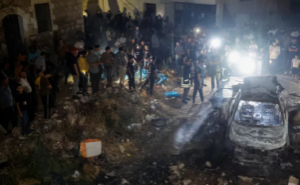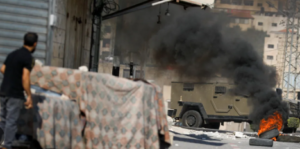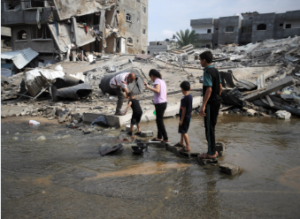Keywords: Israeli airstrikes, West Bank violence, Tubas attack, Palestinian casualties, Israeli military raids, Far’a refugee camp, Jenin offensive, UN condemnation, Israel-Palestine conflict, occupied West Bank
At least six Palestinians, including a teenager, were killed in a series of Israeli airstrikes and military raids in the occupied West Bank’s Tubas region. This deadly escalation is part of an ongoing Israeli military offensive that has intensified across the West Bank, leading to a significant rise in casualties and destruction.
Deadly Airstrike in Tubas:
- Israeli Drone Strike: In the early hours of Thursday, an Israeli drone targeted a car in the city of Tubas, killing at least five Palestinians. The airstrike left two others injured, with one in critical condition. The bodies of the deceased were transported to the Tubas Turkish Government Hospital by Palestine Red Crescent Society ambulance crews.
- Teenager Shot Dead: In a separate incident, Israeli forces shot and killed 16-year-old Majed Fida Abu Zeina in the Far’a refugee camp within the Tubas governorate. Witnesses reported that after shooting the boy, Israeli soldiers prevented medical personnel from reaching him and used a military bulldozer to drag his body out of the camp.
- Ongoing Israeli Military Operations:
- Israeli Justification: The Israeli military confirmed that its aircraft participated in “three different attacks” on Palestinian fighters in the Tubas region, claiming that the targets posed a direct threat to their forces.
- Expanded Raids: In addition to the airstrike, Israeli forces conducted a raid on the al-Ein refugee camp near Nablus, as part of a broader military operation across the West Bank. These actions have sparked widespread violence and led to numerous casualties.
- Context and Impact:
- Rising Casualties: Since the beginning of the Israeli military offensive last week, the death toll has risen to at least 38 Palestinians, with 130 others wounded. The Jenin area has been particularly affected, witnessing extensive raids and widespread destruction.
- UN Condemnation: The United Nations Office for the Coordination of Humanitarian Affairs (OCHA) condemned Israel’s use of “lethal war-like tactics” in the West Bank. The OCHA highlighted the severe impact on civilians, including children, and has mobilized international organizations to assess and address the urgent humanitarian needs in the region.
- Escalating Conflict:
- Most Extensive Assault Since Second Intifada: The current Israeli military operations are the largest in the West Bank since the second Intifada in the early 2000s. The raids have caused significant damage to infrastructure, including roads, and have led to numerous arrests in refugee camps such as Tulkarem and Jenin.
- Humanitarian Crisis Deepens: As the conflict intensifies, the humanitarian crisis in the West Bank worsens. Residents face shortages of food, medicine, and other essential supplies, exacerbating the already dire conditions in the occupied territories. The latest Israeli airstrikes and military raids in the Tubas region underscore the growing violence and humanitarian crisis in the occupied West Bank. As the death toll rises and the destruction continues, there is increasing concern about the long-term stability of the region and the impact on Palestinian civilians.

.Key Events and Context:
- Israeli Airstrike and Ground Raids:
- The Israeli military’s actions involved a drone strike targeting a vehicle in Tubas, killing at least five Palestinians. This is part of Israel’s broader military operations across the West Bank, which have intensified in recent weeks.
- Separately, a 16-year-old Palestinian boy, Majed Fida Abu Zeina, was shot dead by Israeli forces in the Far’a refugee camp. The incident underscores the ongoing and often brutal nature of these military operations, which frequently target young Palestinians.
- Military Justifications:
- The Israeli military stated that the airstrikes targeted Palestinian fighters who posed an immediate threat to their forces. However, such justifications are often contested by Palestinian sources and human rights organizations, which argue that these actions disproportionately impact civilians and violate international law.
- Impact on Civilians and Humanitarian Concerns:
- The death toll and the number of injured Palestinians have been rising due to the intensified military operations. Since the offensive began, over 38 Palestinians have been killed, with a significant portion of the casualties in the Jenin area.
- The United Nations, through the Office for the Coordination of Humanitarian Affairs (OCHA), has condemned Israel’s tactics, labeling them as “lethal war-like.” The UN has raised alarms about the humanitarian crisis, particularly the destruction of infrastructure and the impact on civilian lives.
- Broader Political and Military Context:
- The Israeli operations in the West Bank are the most extensive since the second Intifada (early 2000s), a period marked by widespread violence between Israeli forces and Palestinians.
- These raids are part of a larger Israeli strategy to maintain control over the occupied territories, but they also serve to suppress resistance movements within Palestinian communities.
- International Reactions and Diplomacy:
- The international community, including various human rights organizations, has expressed concern over the rising violence and the humanitarian impact on the Palestinian population. The situation in the West Bank is closely monitored, especially by countries involved in Middle East peace processes.
- The ongoing violence and military operations are likely to strain Israel’s diplomatic relations, particularly with countries that advocate for Palestinian rights and a two-state solution.
- Additional Data Sources:

- Palestinian Perspective:
- Palestinian news agencies like Wafa provide real-time updates on the ground, offering insights into the immediate impact on communities. They often highlight the civilian toll and the destruction of property.
- Israeli Military Statements:
- The Israeli Defense Forces (IDF) typically release statements justifying their actions, which are crucial for understanding the official Israeli narrative. These statements can be contrasted with reports from independent organizations to assess the situation comprehensively.
- Human Rights Reports:
- Organizations like Amnesty International, Human Rights Watch, and the United Nations often release detailed reports on the human rights implications of such military operations. These reports provide evidence-based assessments of violations and their impact on civilians.
- Historical Context:
- The second Intifada and subsequent military operations in the West Bank are well-documented. Understanding this history is essential for contextualizing the current violence and Israel’s long-term strategy in the region.
The situation in the Tubas region is part of a larger, ongoing conflict between Israel and Palestine, marked by frequent military operations and significant civilian casualties. The humanitarian crisis resulting from these operations is severe, with international organizations increasingly concerned about the long-term impact on Palestinian communities. Understanding the historical context, the narratives from both sides, and the international response is crucial for a comprehensive analysis of the situation

